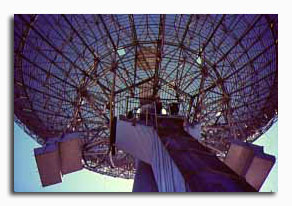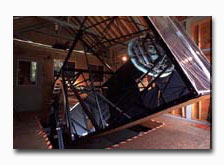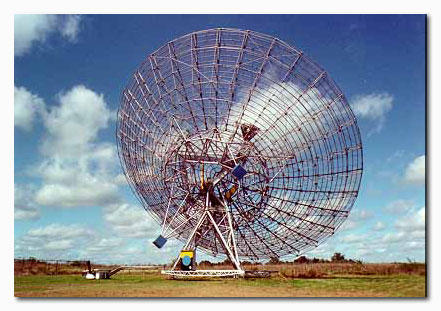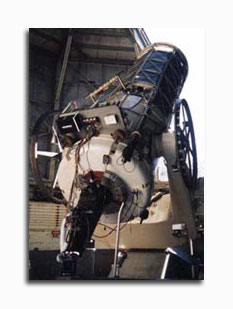By Dominic McNamara © AUFORN - AURA South Australia
The Australasian UFOlogist Magazine Vol.8 NO.5
This is a collection of Articles based in Facts. These articles cover life's formation, existence and struggle to survive. In fact, if you look hard enough, life has survived some of the strangest, remote and sometimes, unexpected places.
“SEARCHLIGHTS”
In 1959, at a place called West Virginia in the United States, a man named Frank Drake began a project he called “Ozma” (meaning 'a land far away'). In this project, Drake used equipment to listen to a couple of nearby stars to see if there were life forms using or sending radio based signals. For the record, this has been accepted as the first time people would be involved in a serious search for Extra Terrestrial Intelligence (SETI). But this was a passive activity, the first case of 'listening'. Barring general Radio Frequency (RF) transmissions which radiate out into space, we were not 'active'; i.e., we didn't 'say' much.
| In the mid-seventies, the Voyager Spacecraft carried with her a gold LP containing imaging and sounds of Earth to anyone who might come into contact with the vessel as she sailed out into interplanetary space. They would of course have needed to understand how to play a “33” on a gramophone but that didn't deter us and at least we were trying. Believe it or not, after all these years, Voyager is finally crossing the Heliopause - thus entering interstellar space. But it would appear that we have stopped wanting to talk to the stars, let alone whomsoever might occupy their systems. After all, this was the only time we ever actually 'said' anything. Thereafter, we have only listened - and to varying degrees at that.
|
||||
 |
||||
|
|
||||
Most people believe in the 'planet killer' sized asteroid and the possibility of it's hitting the Earth. They also think it a good idea that we should keep a lookout for such objects and have a nuclear warhead or two on hand to “split em up the middle” whenever one gets too close for comfort. The fact that we are not doing a very good job of such a thing is down to an economic world. Many however think it ridiculous to be actively involved in SETI. After all, it is a large financial cost to governments and individuals alike and detracts from other budgets - not to mention the fact that there just couldn't be such a thing.
Even if some personnel involved in our space missions believe in intelligent life somewhere else in the universe, it is hard to persuade anyone signing off on the bills to include either a 'message in a bottle' , an invitation to say hello, or at the very least, a 'searchlight' for intelligent life.
Currently, there are plans to look for fossils on rocky inner planets and an ambitious 'try' is on the cards for underwater life on a far away moon in our solar system. But there are no plans for listening or talking from any of our robotic ventures in an 'intelligent' manner. As we toy with the idea of venturing out into interstellar space, everything from Science fiction to believers in E.T. tell us we are supposed to begin making small incursions into 'someone else's Space'. Here also, as with Near Earth Objects, we know the possibilities, have considered the consequences, yet do nothing about “real plans”.
 |
||||||||||
There are rows of Radio Telescopes and proposals as to what to listen for with regard to incoming 'signals'. SETI is even a research foundation accessible on the web in a manner which gives enthusiasts the opportunity to become participants through the use of their own computers. Fast Fourier Transform (number crunching) and signal sorting from off axis results would take up more years and computer processing than are available. But each of our computers can do some of the work even if only during the time we are away and the screensaver has activated. For more details on how you can become involved and watch your involvement in SETI@home in a screensaver on your PC, visit the site at; http://setiathome.berkeley.edu/ |
||||||||||
| From beneath the Harvard/Smithsonian Telescope in Massachusetts, where project BETA operates searching 250-million channels for radio signals from acorss the universe | ||||||||||
 |
||||||||||
| I have the program running on my machine. I can't help thinking that intelligent life in the universe has probably gone past the transmission of Radio signals as a pastime, but they might just consider 'talking' to us in this known format by deliberacy - knowing that it is our communicative medium of choice. Unfortunately, we know of no other. |
||||||||||
 |
||||||||||
| This strange object, that looks nothing at all, representing one of the most ambitious SETI projects ever undertaken: an optical telescope dedicated exclusively to the search for extraterrestrial life. The 72" Optical SETI telescope in Harvard, Massachusetts. | ||||||||||
 |
||||||||||
| This 34 - meter (about 98 - foot) wide telescope near Buenos Aires scans the southern hemisphere. The photo: Argentine institute of Radio Astronomy.
|
||||||||||
| The 61 - inchoptical telescope in Harvard, Massachusetts. The experiment's photometer can detect pulses as short as a few billionths of a second. Searching for narrow-band laser pulse SETI signals was first suggested by Nobel prize winner Charles Townes of the University of California, Berkeley. | ||||||||||
Until then, have a safe journey through Christmas and the New Year.